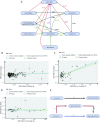Meal-induced inflammation: postprandial insights from the Personalised REsponses to DIetary Composition Trial (PREDICT) study in 1000 participants
- PMID: 34100082
- PMCID: PMC8408875
- DOI: 10.1093/ajcn/nqab132
Meal-induced inflammation: postprandial insights from the Personalised REsponses to DIetary Composition Trial (PREDICT) study in 1000 participants
Abstract
Background: Meal-induced metabolic changes trigger an acute inflammatory response, contributing to chronic inflammation and associated diseases.
Objectives: We aimed to characterize variability in postprandial inflammatory responses using traditional (IL-6) and novel [glycoprotein acetylation (GlycA)] biomarkers of inflammation and dissect their biological determinants with a focus on postprandial glycemia and lipemia.
Methods: Postprandial (0-6 h) glucose, triglyceride (TG), IL-6, and GlycA responses were measured at multiple intervals after sequential mixed-nutrient meals (0 h and 4 h) in 1002 healthy adults aged 18-65 y from the PREDICT (Personalised REsponses to DIetary Composition Trial) 1 study, a single-arm dietary intervention study. Measures of habitual diet, blood biochemistry, gut microbiome composition, and visceral fat mass (VFM) were also collected.
Results: The postprandial changes in GlycA and IL-6 concentrations were highly variable between individuals. Participants eliciting an increase in GlycA and IL-6 (60% and 94% of the total participants, respectively) had mean 6-h increases of 11% and 190%, respectively. Peak postprandial TG and glucose concentrations were significantly associated with 6-h GlycA (r = 0.83 and r = 0.24, respectively; both P < 0.001) but not with 6-h IL-6 (both P > 0.26). A random forest model revealed the maximum TG concentration was the strongest postprandial TG predictor of postprandial GlycA and structural equation modeling revealed that VFM and fasting TG were most strongly associated with fasting and postprandial GlycA. Network Mendelian randomization demonstrated a causal link between VFM and fasting GlycA, mediated (28%) by fasting TG. Individuals eliciting enhanced GlycA responses had higher predicted cardiovascular disease risk (using the atherosclerotic disease risk score) than the rest of the cohort.
Conclusions: The variable postprandial increases in GlycA and their associations with TG metabolism highlight the importance of modulating TG in concert with obesity to reduce GlycA and associated low-grade inflammation-related diseases.This trial was registered at clinicaltrials.gov as NCT03479866.
Keywords: glycoprotein acetylation; inflammation; postprandial glycemia; postprandial lipemia; visceral fat mass.
© The Author(s) 2021. Published by Oxford University Press on behalf of the American Society for Nutrition.
Figures



Comment in
-
Postprandial metabolism and inflammation-a comprehensive model to advance Precision Nutrition? Lessons learned from the Personalised REsponses to DIetary Composition Trial (PREDICT study).Am J Clin Nutr. 2021 Sep 1;114(3):841-842. doi: 10.1093/ajcn/nqab200. Am J Clin Nutr. 2021. PMID: 34143866 Free PMC article. No abstract available.
References
-
- Lopez-Garcia E, Schulze MB, Fung TT, Meigs JB, Rifai N, Manson JE, Hu FB. Major dietary patterns are related to plasma concentrations of markers of inflammation and endothelial dysfunction. Am J Clin Nutr. 2004;80(4):1029–35. - PubMed
-
- Wu JHY, Micha R, Mozaffarian D. Dietary fats and cardiometabolic disease: mechanisms and effects on risk factors and outcomes. Nat Rev Cardiol. 2019;16(10):581–601. - PubMed
-
- Schmidt AM, Yan SD, Wautier JL, Stern D. Activation of receptor for advanced glycation end products: a mechanism for chronic vascular dysfunction in diabetic vasculopathy and atherosclerosis. Circ Res. 1999;84(5):489–97. - PubMed
Publication types
MeSH terms
Substances
Associated data
Grants and funding
LinkOut - more resources
Full Text Sources
Medical
Miscellaneous

